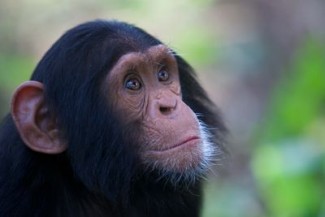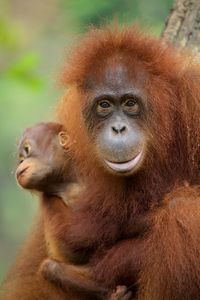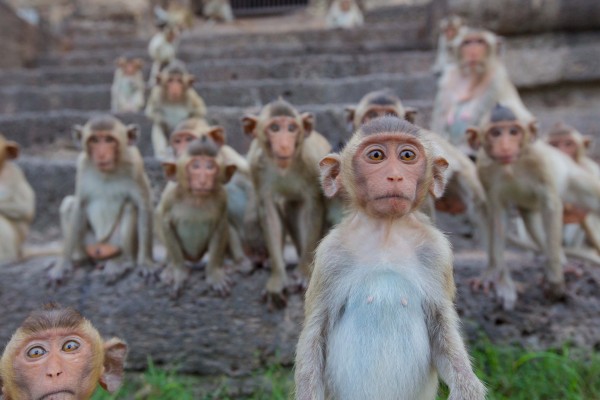INTERVIEW: Jane Goodall Institute videographer discusses chimps on eve of TV special

Bill Wallauer has one of the coolest jobs on planet earth. Since 1992, he’s been working with Jane Goodall and her research institute to study and record chimpanzee behavior in Gombe National Park, Tanzania. The documentarian’s footage has been used for many TV programs, and some of his best work will be showcased Tuesday, Oct. 21 at 8 p.m. on Animal Planet as part of a special called The Real Apes of the Planet.
“I went over to Tanzania as a Peace Corps volunteer and met Jane, and when I was done with Peace Corps, spent a few months studying spotted owls in southern Oregon,” Wallauer told Hollywood Soapbox recently. “And then Jane asked me to come back, and that was history. It was the perfect match for me. I just love Africa. The forest was phenomenal. The chimps were phenomenal. The first time I met a chimp, it was kind of life changing. It’s become my life.”
Most of Wallauer’s videography work has been in Gombe National Park, the famed habitat in Tanzania that has been the location of Goodall’s chimpanzee studying since the early 1960s. It’s a global spot of almost mythic proportions; it was in these forests where Goodall first viewed chimpanzees and their incredible skill sets, including tool-making and hunting.

“I’ve done over 40 films now; most of it has been done in Gombe,” he said. “In the very, very beginning, I spent a lot of time with elephants, and I just loved watching their behavior. While I had a little Pentax still camera, this is the time when the little high-8 cameras were coming out. .. It’s a little video camera from the early ‘90s, and so I bought one just to kind of take my own home movies of my experience in Gombe. And Jane was just delighted because she said, ‘Wow, that little camera, you can actually follow the chimps and get behavior.'”
Goodall asked Wallauer to film a chimpanzee weaning another chimpanzee. At the time, he had no idea about documentary filmmaking or chimpanzee behavior, so he just hit record to see what might happen. “And then film crews would come and use me as a scientific adviser in the beginning and then realized because I knew the chimps [and] the behavior so well that 90 percent of wildlife filmmaking is really understanding the species you’re filming,” he said. “So it just became a perfect match. So a crew would come and kind of teach me how to shoot for editing, which is a very different thing as it is for research. … I got trained in the field by some of the best cinematographers in the business.”
Wallauer was in Gombe almost full time from 1992 to 2006. He used to work 10 or 11 months in the park and then take a break for a month or so. His work, and the overall efforts of JGI, is important for many reasons, especially since chimps are critically endangered and face continued loss of habitat. The videographer said this great primate can be lost in his lifetime.
JGI reports that chimpanzee populations were at one million in the early 1900s. Today those numbers hover somewhere between 150,000 and 300,000. Chimps and other primates are facing some monumental obstacles, so TV specials take on a greater meaning when they are tied to the realities faced in the wild.
For the new Animal Planet special, viewers will have the chance to see footage that Wallauer originally shot for BBC’s Planet Earth. “They hired me to collect that hunting and territorial patrol behavior of chimps in Uganda, and so they used that footage of mine for this film,” he said. “Historically I would just get a shot list. I’d be in the field doing my research videography, and they’d just send out a shot list and a whole bunch of really fun equipment. And I’d just kind of tick off the shot list — this is what they want, this is what they want — and I’d let the chimps tell the story of however they wanted to tell it. So there is no script really. If you write a script for chimps, they’re going to write another one because what they do is far more imaginative and interesting than any script we can come up with.”

In 2015, Wallauer is gearing up for an 88-day shoot for National Geographic. He’ll likely rely on his expert knowledge of the Gombe chimpanzees, primates he’s come to know quite well.
“Each chimp has a very individual look, but at first glance, they all look exactly the same. From the first day Jane set foot on Gombe, she started habituating the chimps, started recognizing them as individuals. If you went out for a month, and I showed you Ferdinand, and Titan, and Tarzan and all of these guys who are there in the forest, you would start recognizing them for their personalities, their facial expressions. The same features that we recognize in each other we start picking up in chimps, right away. That process would happen in your brain right away. This is the same study group which has been studied since 1960 by Jane, so these chimps have been followed for four nearly five generations.”
Wallauer sometimes can even catch a glimpse of Sparrow, a chimpanzee that may be approaching 50 years old, which would date back to Goodall’s original studies in the 1960s. “Yeah, they can live 50 years in the wild,” he said. “In captivity, much longer because they have the same style of western healthcare and nutrition that we have, but it’s not a very nice life living in captivity. I’d rather live happy and wild than in a cage with doctors around me.”
Programs like The Real Apes of the Planet, plus the work of Goodall and Wallauer, open up a world that sometimes is only experienced by viewers through the comfort of a television screen. If a traveler is unable to make it to Gombe National Park and see chimpanzees in their wild habitat, these documentaries become important views into a world that’s so real and yet can feel so far away.
“That’s what my passion is, for people who don’t experience wildlife in the way I get to just because of access through my lens and through the stories that I see unfolding in the wild,” Wallauer said. “I just think it’s a wonderful tool to tell beautiful stories about nature and bridge that gap. I think there really is in the last few generations a loss of contact with nature in a way. We don’t go on walks anymore. We don’t have a connection to the land, and the forest, and the desert and these wonderful wild places. People just don’t get [out] or take the time to go there. It’s kind of rekindling that spark in all of us that is so moved by natural beauty and wildlife.”
By John Soltes / Publisher / John@HollywoodSoapbox.com

